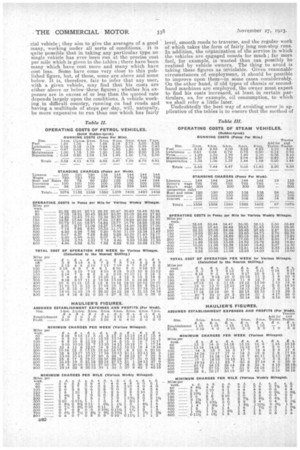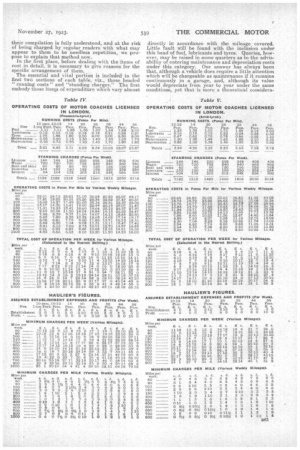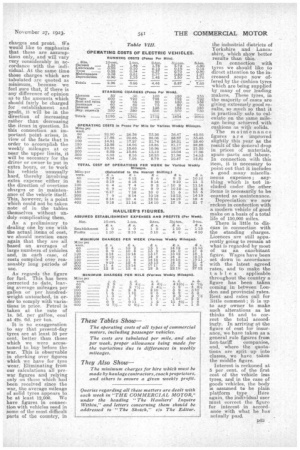RUNNING COSTS OF ALL TYPES OF VEHICLES.
Page 63

Page 64

Page 65

Page 66

Page 67

If you've noticed an error in this article please click here to report it so we can fix it.
WE repeat, once more, with revisions and corrections• to date, our tables of operating costs and hire charges for commercial motor vehicles, and we do so on this occasion with the additional pleasure and gratification which we derive from the knowledge that they are now regarded a8 the standard publication on the Subject, being looked to in that light, not only by commercial users and haulage contractors, but by Government departments. In view of this striking evidenceof their import. mice, it would 'behove us to use increased care in their compilation were there any room for it ; in any case, it is more than ever necessary to accompany them with a word of warning, so as to obviate the possibility of their misuse through misunderstanding. This warning may best take the form of declaring what.the tables do not show. They-do not definitely indicate the precise cost of running of any commer cial vehicle they aim to give the averages of a good many, working under all sorts of conditions. it is quite ,possible that in taking any particular type no single vehicle has ever been run at the precise cost per mile which is given in the tables ; there have been many which have cost more and many which have cost less. Sonic have come very close to this published figure, but, of those, some are above and some below. It is, therefore, fair to infer that any user, with a given vehicle, may find that his costs are either above or below-these figures ; whether his expenses are in excess of or less than the quoted rate depends largely upon the conditions. A vehicle working.in difficult country, running on bad roads and having a multitude of stops per day, will, naturally, he more expensive to run than one which has fairly
level, smooth roads to traverse, and the regular work of which takes the form of fairly leng non-stop runs. In addition, the organization of the service in which the vehicles arc engaged counts for much; far more fuel, for example, is wasted than can possibly be realized by vehicle owners. The thing to avoid is taking these figures as inviolable. Given reasonable circumstances of employment, it should be possible to improve upon them-in some 'cases considerably. On the -other hand, if old types of chassis or secondhand machines are employed, the owner must expect to find his costs increased, at least in certain particulars, as, for example, oil consumption, to which we shall refer a little later.
Undoubtedly the best way of avoiding error in application of the tables is to ensure that the method of
their compilation is fully understood, and at the risk of being charged by regular readers with what may appear to them to be needless repetition, we propose to explain that method now. In the first place, before dealing with the items of cost in detail, it is necessary to give reasons for the specific arrangement of them. The essential and vital portion is included in the first two sections of each table, viz., those headed "running costs" and "standing charges." The first embody those items of expenditure winch vary almost
directly in accordance with the mileage covered. Little fault will be found. with the inclusion under this head of fuel, lubricants and tyres. Queries, however, may be raised in Some quarters as to the advisability of entering maintenance and depreciation costs under this category. Our answer has alwayS been that, although a vehicle does require a little attention which will be chargeable as maintenance if it remains continuously in a garage, and, although its value would depreciate from year to year under the same conditions, yet that is more a .year considera
tion and one which need not be discussed in relation to such tables as these, which are not intended to cater for vehicles so maintained.
The standing charges are such as to offer no basis for argument. They are the items of expense which do not vary in accordance with the mileage of the lorry. If the vehicle is on the road at all it must be licensed, and must have a driver for whom wages must be reckoned. Unless it is running continuously from year end to year end it must be garaged, and there is always the item of interest on first cost to be reckoned against it. The Second and third sections of the table are ob.. tamed from the first merely by arithmetical calculations. it is obviously going to cost less per mile to run a vehicle as its weekly mileage increases, since the incidence of the standing charges decreases as the mileage increases. The total cost of operation per week, a course, increases with the mileage, but not in proportion.
For the purpose of arriving at an approximate estimate of the charges at which a haulage contractor should make for the hire of his vehicles, it has been necessary to make assumptions as to establishment charges and pront. We would like to emphasize that these are assumptions only, and will vary rery considerably in accordance with the individual. At the same time those charges which are tabulated are quoted as minimum, because we feel sure that, if there is any difference of opinion as to the amounts which should fairly be charged for establishment and profit,. it will be in the direction of increasing rather than decreasing the items in question. In this connection an important point arises, in view of the facts that in order to accomplish the weekly mileages at or near the upper limits, it will be necessary for the driver or owner to put in extra hours, or to work his vehicle unusually hard, thereby involving extra expense either in the direction of overtime charges or in maintenance of the vehicle itself. This, however, is a point which eould not be taken note of in the tables themselves without unduly complicating them.
As a preliminary to dealing one by one with the actual items of cost, we should mention once again that they are all based on averages of large numbers of vehicles and, in each case, of costs compiled over reasonably long periods of use.
As regards the figure for fuel. This has been corrected to date, leaving average mileages per gallon or per hundredweight untouched, in order to comply with variations in price. Petrol is taken at the rate of is. 3d. per gallon, coal at 42s. 6d. per ten.
It is no exaggeration to say that present-day tyres are at least 50 per cent. better than those which we were accustomed to buy before the war. This is observable in checking over figures which we have for tyre wear. Eliminating from our calculations all prewar figures and relying only on those which had been received since the war, the average mileage of solid tyres appears to be at least 12,000. We have figures in connection with vehicles used in some of the most difficult parts of the country, in the industrial districts of Yorkshire and Lancashire, which show better results than this.
In connection with tyres We should like to direct attention to the increased scope now offered by the cushion tyres which are being supplied by many of our leading makers. These tyres, in the majority of cases are giving extremely good results, so much so that it is practically safe to Calculate on the same mileage being achieved with cushions as with solids.
The maintenance figures a r e improved slightly this year as the result of the general drop in prices of materials, spare parts and labour. In connection with this item, it is necessary to point out that it includes a good many miscellaneous expenses ; anything which is not included under the other items is necessarily to be connted as maintenance.
Depreciationwe now reckon in confiection with a modern vehicle of good make on a basis of a total life of 150,000 miles.
There is little to disems in connection with the standing charges. Licences are still apparently going to remain at i what s regarded by most of us an exorbitant figure. Wages have been set down in accordance with the latest agreed rates, and to make the
table s applicable throughout the country a figure has been taken coming in between London and provincial rates. Rent and rates call for little comment ; it is up to any owner to make such alterations as he thinks fit and to correct the total accordingly. In arriving at the figure of cost for insurance, we have taken as a general rule figures from
non-tariff companies, and, where the quotations are split up into classes, we have taken the middle figure.
Interest is reckoned at 5 per cent, of the first cost of the vehicle less tyres, and in the case of goods vehicles, the body is assumed to be plain platform type . 'Here again, the indrsidual user must correct the figure for interest in accordance with what he has actually paid.








































































